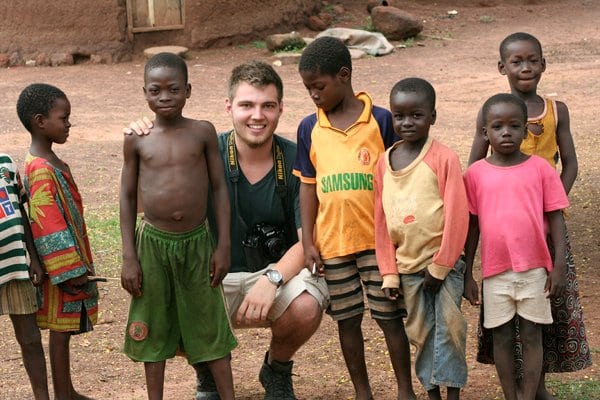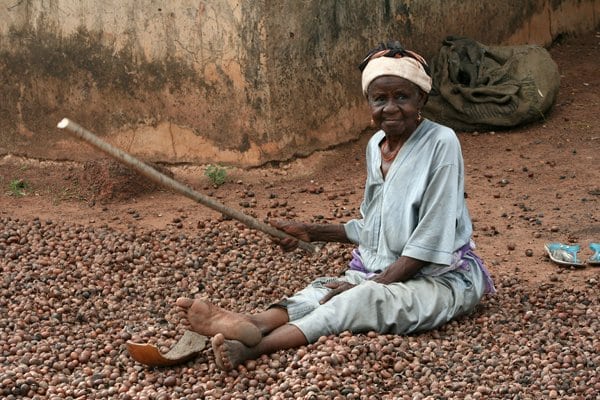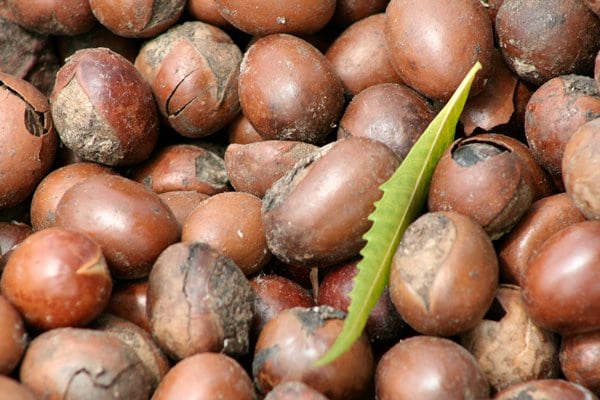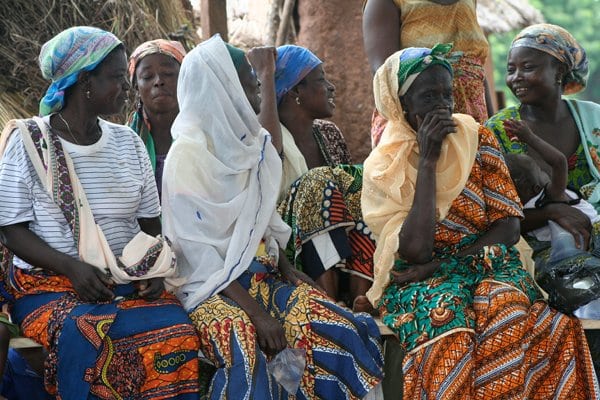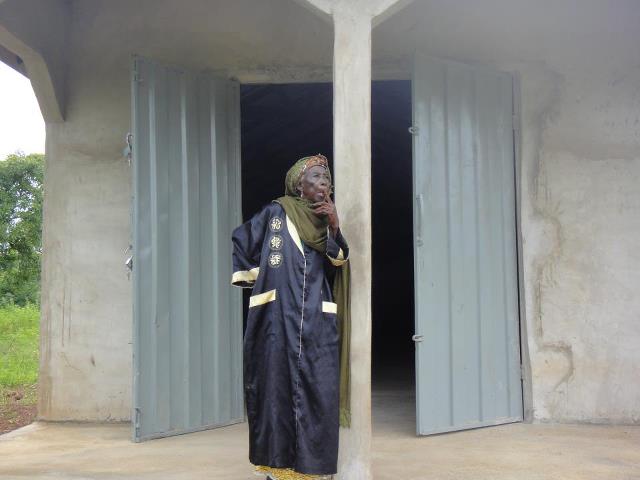Helping Ghana's Women Prosper
Photos By: Maryann Fernandez, unless otherwise noted
During a philanthropic journey to Ghana during the summer of 2011, we visited fair-trade cocoa cooperatives, organizations fighting child trafficking, and participated in mobile health and enterprise development projects– experiences that were personally transformative to each of us.
Just one of many highlights was our day in Gushie visiting then start-up organization, Just Shea. One of our travelers, a young photographer and budding philanthropist, Adam Ottke, was so moved by the experience that he shared a beautiful photograph and personal narrative which provided many insights into daily village life and the economic situation in Northern Ghana.
. . . . . . . . . . . . . . . . . . . . . . . . . . . . . . . . . . . . . . . . . . . . . . . . . . . . . . . . . . . . . . . . . . . . . . . . . . . . . . . . . . . . . . . . . . . . . . . . . . . . . . . . . .
The Magazia’s Hands
Adam making friends with the children of Gushie.
The Magazia is the most respected female elder in the rural, northern Ghanaian township of Gushie (pronounced goo-shay). In Gushie, hundreds of local women wade through chest-high grasses to gather shea nuts for a living, a job that comes with great hazard. The region is home to scorpions, black and green Mambas- two of the most venomous snakes in the world. The women often succumb to the deadly effects of these stings and bites due to no access to medical help. The only higher cause of death for women in this region is childbirth.
When Danielle Warren witnessed these hardships, she decided something had to change. Getting the women of Gushie protective boots, gloves and coats became her top priority. She had two realizations: 1) Donations would take time and might not cover the growing need within Gushie, 2) The people of Gushie could not afford their own gear because they were not receiving fair prices for their shea nuts.
Through off-season, harvesters are desperate to return to picking shea nuts for a source of income. Knowing this, middlemen bid farmers against each other for the lowest price possible on the newly fallen nuts, keeping the price for shea nuts extremely low, despite their high export value for use in countless shea butter products.
A Gushie woman cracking shea nuts.
The solution: Build a silo to store the shea nuts so harvesters could delay selling until the end of the season, when the lack of supply drives up demand and, subsequently, drives up prices in Europe. If the entire town could agree to use a silo, it would have an incredible amount of selling power simply because of the quantity of what would be stored and sold together. However, building a silo meant not only raising funds for the project, but also meant waiting an entire season without making money.
Getting the Magazia to understand the project and its potential for Gushie was essential to getting the entire village on board. Eventually, she agreed to Danielle’s plan for safer conditions and fairer pricing.
Danielle raised funds for the project and set up a loan program so that villagers could borrow money to get them through the year until they could sell their cache of shea nuts in the off-season. The additional income garnered by selling shea nuts at a premium would eventually be enough to support the harvesters’ families throughout the year and pay off any loans.
Shea nuts, a source of income for many Gushie locals.
Yet Danielle still needed to raise funds for protective gear so she developed Just Shea, a non-profit that would sell its own line of skin creams using Gushie’s shea nuts. Just Shea is now sold internationally; directly through its company website and indirectly through various online retailers and stores in New York City.
The Magazia continues to advise her township. Her hands – stained red from the daily application of an herbal ointment believed to have health benefits – are riddled with wrinkles that hint at her age. But no one – not even the magazia herself – knows her exact age. All she knows is that the giant tree that now serves as the town center was about her height when she was younger.
. . . . . . . . . . . . . . . . . . . . . . . . . . . . . . . . . . . . . . . . . . . . . . . . . . . . . . . . . . . . . . . . . . . . . . . . . . . . . . . . . . . . . . . . . . . . . . . . . . . . . . . . . .
An interview with Just Shea Founder, Danielle Grace Warren.
Danielle Warren conducting intake surveys.
MF: How many women did you start with when we visited in 2011 and how many are there now?
DW: In 2008 when we first visited there was a loose knit group of women in the community, but they weren’t galvanized around anything in particular. In the 2011, when you came to visit, we did intake and social data surveys with 37 women, selected by Magazia and other women elders, to participate in the pilot. We just signed on an additional 11 women, bring our total to 48, and we plan to add another 25 before the end of this season.
MF: I remember. That was a long day, but rewarding. Tell me a little about the shea industry.
DW: In Ghana alone, more than 900,000 women collect over 130,000 tons of dry shea nuts annually and the industry benefits close to two million poor people in the country, 95% of who are from rural households. The shea trade earns at least $30 million of foreign exchange for the national economy annually, and has the capacity to triple that amount.
MF: How prevalent are snake and scorpion bites when women collect shea nuts?
DW: In 2002 it was determined (by a USAID survey) that 5% of women shea harvesters had been bitten. We (One Village Planet- Womenʼs Development Initiative) undertook a series of surveys in the area surrounding Tamale (capitol of Ghanaʼs Northern Region), and, in our initial findings, 14% (or one in seven women) were bitten, some more than once, and only one was treated at a medical facility. The Ghana Trades and Livelihoods Coalition estimates that 60% of the available shea is left uncollected in the bush because of difficulties faced by the women shea nut harvesters.
Many Gushie women make a living by harvesting shea nuts.
MF: Is this the biggest stumbling block to women being able to make more money from shea?
DW: Another big stumbling block is selling their harvest. One quarter of the shea nuts that are harvested from Ghana’s shea trees are neither sold nor processed domestically because women harvesters struggle to get their sheanuts to market.
The price of shea ranges dramatically over the course of a season. For example, in 2011 it ranged from 15 USD per bag to over 50 USD. The rural women we target are currently selling less than 75% of what they harvest (about 2.4 bags per woman) at an average of 17.25 USD per bag. Each woman earning 41.40 USD annually.
MF: What have been the results in Gushie to date?
DW: This March, I distributed the first payment to the women harvesters. Our entire crop was purchased by a socially responsible, multinational buyer and as a result we were able to distribute double the usual amount of payments to the women. This is an incredible augmentation to the village collective and a resounding gong of success that will echo across the village, encouraging others to join in. We envision that this will encourage and exhort expansion elsewhere in the region.
MF: What do you project your growth to be in the next 2 years?
DW: We plan to reach 300 women total and start in one new village, as well as to have Gushie self-sustaining.
MF: And what does the Magazia think of all of this?
DW: She’s always been our biggest supporter and is proud to be a part of this.
. . . . . . . . . . . . . . . . . . . . . . . . . . . . . . . . . . . . . . . . . . . . . . . . . . . . . . . . . . . . . . . . . . . . . . . . . . . . . . . . . . . . . . . . . . . . . . . . . . . . . . . . . .
The Magazia in front of the storage silo. Credit: Just Shea.
I hope Adam’s narrative and my interview with Danielle has inspired you to try this kind of meaningful journey where travelers explore critical issues and connect with innovative social entrepreneurs in vibrant local communities off the conventional tourism track.
A handful of Adam Ottke’s photographs are for sale, each with a personal narrative. 40% of the net proceeds benefit Just Shea. Visit Adam Ottke Photography to purchase.
Maryann Fernandez is the Founder & President of Philanthropy Indaba. Please contact Maryann for more information on how to plan your philanthropic journey.

